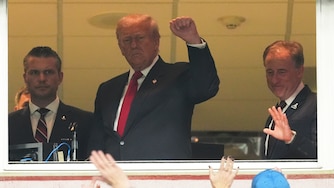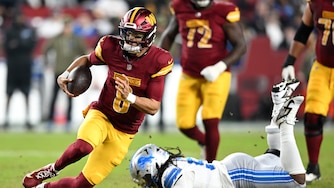PHOENIX — At the end of the day, the offer the Orioles made to right-hander Corbin Burnes was not enough to bring him back to Baltimore. The reasons for that vary — and even Burnes admits his decision was not straightforward.
“I can’t guarantee I would’ve gone there [Baltimore] had this offer not come around,” Burnes said in the dugout at Chase Field before Tuesday’s game against his new team, the Arizona Diamondbacks. “It’s tough to play the what-if game.”
Forget the what-if game, then. Here’s what we know. The Orioles offered Burnes a four-year contract worth $180 million. That’s an average annual value of $45 million, which would have made Burnes the highest-paid pitcher in baseball.
He chose a longer deal worth $10 million less per year (and $30 million more in total), and that’s his decision. Burnes earned that right in free agency. He ended up signing in Arizona, where his family lives, and that clearly played a role in his decision.
It was not, as Orioles owner David Rubenstein has suggested, the only factor, though.
Read More
In a recent interview with Baltimore magazine, Rubenstein said that money wasn’t the issue when it came to Burnes. “I’m not sure any amount of money would have made much difference,” he said. “We were prepared to put in the money necessary.”
Rubenstein has a reason to share that detail of a private negotiation publicly. It answers a question fans have asked since he took control of the team a year ago.
Yes, the Orioles are willing to pay up when they feel it’s in their best interest.
Burnes’ choice to go public with his account also delivers a pointed message, though. The Orioles are attempting to offer more salary to convince players to sacrifice years of security, and with him, at least, it did not work.
Now, Orioles fans must grapple with what they’ve learned and decide: Is the new ownership group dedicated to bolstering the roster if it is only willing to do so on short-term — and therefore out-of-the-norm — deals?
Looking strictly at the annual salary, the Orioles were willing to shell out — a clear departure from recent years. They haven’t sealed one of these deals yet, perhaps because of the reluctance to offer a long-term contract. But offering $180 million proves the willingness from Rubenstein and general manager Mike Elias to increase payroll if the player fits their mold.
“We didn’t have a financial limit on what he [Elias] could spend or not spend,” Rubenstein said in February.
And perhaps the lack of a financial limit will lead to the sort of contract extensions fans have clamored for or the needed addition of an ace.
But the length of a deal is an important consideration, for Burnes and every other big-time free agent. Many of the recently signed big-money deals in the sport show how players and their representatives value the long-term stability a lengthy deal provides: 26-year-old first baseman Vladimir Guerrero Jr. got 14 years and $500 million from Toronto; 31-year-old third baseman Matt Chapman signed for six years and $151 million with the Giants; 34-year-old second baseman Jose Altuve received 5 years and $125 million from the Astros; and 31-year-old second baseman Ketel Marte tore up his existing contract to sign a six-year, $116.5 million deal with the Diamondbacks.
Of course, there’s every reason to believe the Orioles could be right not to want to be paying Burnes five and six years from now. He’s 30. And, although strikeouts aren’t everything, Burnes’ strikeouts per nine innings dropped from 12.6 in his 2021 Cy Young campaign to 8.4 last year. Still, Burnes produced a 2.92 ERA in 2024. He has also proven his durability, making 32 or more starts for three straight years.
In a recent interview with The Baltimore Banner, agent Scott Boras said winning requires top-end starting pitchers. And “to sign No. 1 pitchers, you’re going to have to give length of contract,” Boras said, “because everyone in the business does, because there are only a few No. 1-type starters, and all of them have a history of getting long-term deals.”
Boras’ perspective is useful. He represents Burnes, for one, but also many of the game’s other top players. Burnes said the Orioles “maybe” would have extended their offer to five years, but overall, “they were kind of set on those [four] years.”
Four years didn’t get it done for Burnes, and there’s no guarantee more would’ve landed him, anyway.
But a four-year contract hasn’t gotten it done for many top starting pitchers. On the market this winter, only left-handers Max Fried and Blake Snell approached the echelon of Burnes. Fried signed an eight-year deal with the New York Yankees, and Snell agreed to a five-year pact with the Los Angeles Dodgers.
Elias hasn’t shown a willingness to offer a long-term deal yet. He signed outfielder Tyler O’Neill to a three-year contract this winter, the first multiyear pact he’s given to a player, but the opt-out after 2025 could cut that short.
And, in a February interview with The Baltimore Banner, Rubenstein offered insight into how the front office views long-term deals for veteran players.
“If you get a pitcher who’s 30 years old and he wants an eight-year contract, how many pitchers pitching at 38 are that good?” Rubenstein said. “There are some. So that’s the issue. The way baseball operates, as you know, you get these long-term deals. If a player gets injured his first year and can’t play again, what do you do?”
That’s the risk. That’s the understanding around baseball. If the Orioles want to land a star player, long-term commitment is important.
Offering Burnes an average annual value of $45 million is admirable. It showed real intent. But, when facing an uphill battle to keep him in Baltimore, away from the pull of family in Arizona, four years wouldn’t cut it (after all, maybe nothing would have).
When it comes to other negotiations, though, there’s value in remembering that the money is one thing. The years are another. And, for many high-level free agents, they go hand in hand.




Comments
Welcome to The Banner's subscriber-only commenting community. Please review our community guidelines.